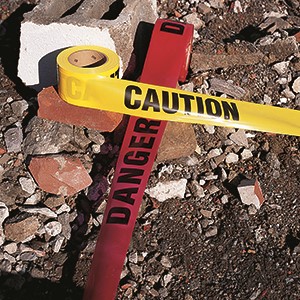Barricade and Marking Tapes: Visibility for Your Work Hazards

Sometimes hazards happen in the workplace because unexpected situations arise. A piece of machinery fails, and the necessary replacement parts get placed on the floor near it while repair is under way. A major storm rolls through, leaving broken windows in its wake. The new work trailer you’ve been waiting for arrives, two days ahead of schedule.
To keep your worksite accident-free and your workers safe on the job, everyone, visitors included, needs to be aware of the specific hazards of their area, as well as those in other areas of the facility or jobsite. Barricade and marking tapes do a great job of drawing attention to these dangers, alerting everyone to use caution in the area of the hazards they may encounter, and limiting access to a work area.
Effective, Versatile Tool
Marking and barricade tape can be utilized on a multitude of job sites. These versatile tapes are effective because of their bright colors and bold messaging.
The colors of the tapes have different meanings:
Caution: yellow tape with contrasting lettering and symbols designates caution. Workers should be watchful and use care to avoid injury.
Warning: orange tape with contrasting lettering and symbols alerts people to a potentially dangerous situation.
Danger: red tape with contrasting lettering and symbols identifies a hazard as a threat to safety and high risk of harm or injury.
The bright colors of tapes are helpful in pointing out hazards, especially those that may not be obvious. It is also a good idea to be consistent in your use of colors of barricade tape and in your other signage. Reinforcing the meanings behind the colors makes it easier for workers to readily understand what they’re seeing.
PVC is the most common type of material for tapes, but if a work site requires it, manufacturers have developed other varieties.
- Woven tapes offer extra durability.
- Reusable tapes allow flexibility in their use. These tapes can be shifted as work progresses, reducing waste.
- Biodegradable tapes are helpful in areas in which it will be difficult to reach them for removal.
- Hazards in low light areas are even more perilous. For extra visibility, reflective tape can be used.
Helpful Tips for Using Barricade and Marking Tapes
- To reduce accidents, safety managers and supervisors should swiftly identify all hazards in the workplace, including office and industrial space, public areas, and spaces outside your facility. Fortunately, barricade and marking tapes are relatively easy to use, and can be deployed quickly.
- Only qualified personnel should put up and take down barricade and marking tape.
- Tape should be positioned so that it’s easily visible and legible from a distance at all times when hazards are present or when work is being performed.
- Workers should be instructed not to cross over or under the tape while it’s barricading a specific area, unless they are specifically granted permission by an authorized person to enter.
- Posting the name and contact information for the person in charge is important if an area is unmanned or could become unmanned at a later time.
- Consider using multi-lingual tapes in you have employees who don’t speak English.
Marking and barricade tapes are an important part of your safety program and are wisely used in conjunction with signs and warning lights. They remind workers to be wary of dangers and hazards, as well as promote safe work practices.



